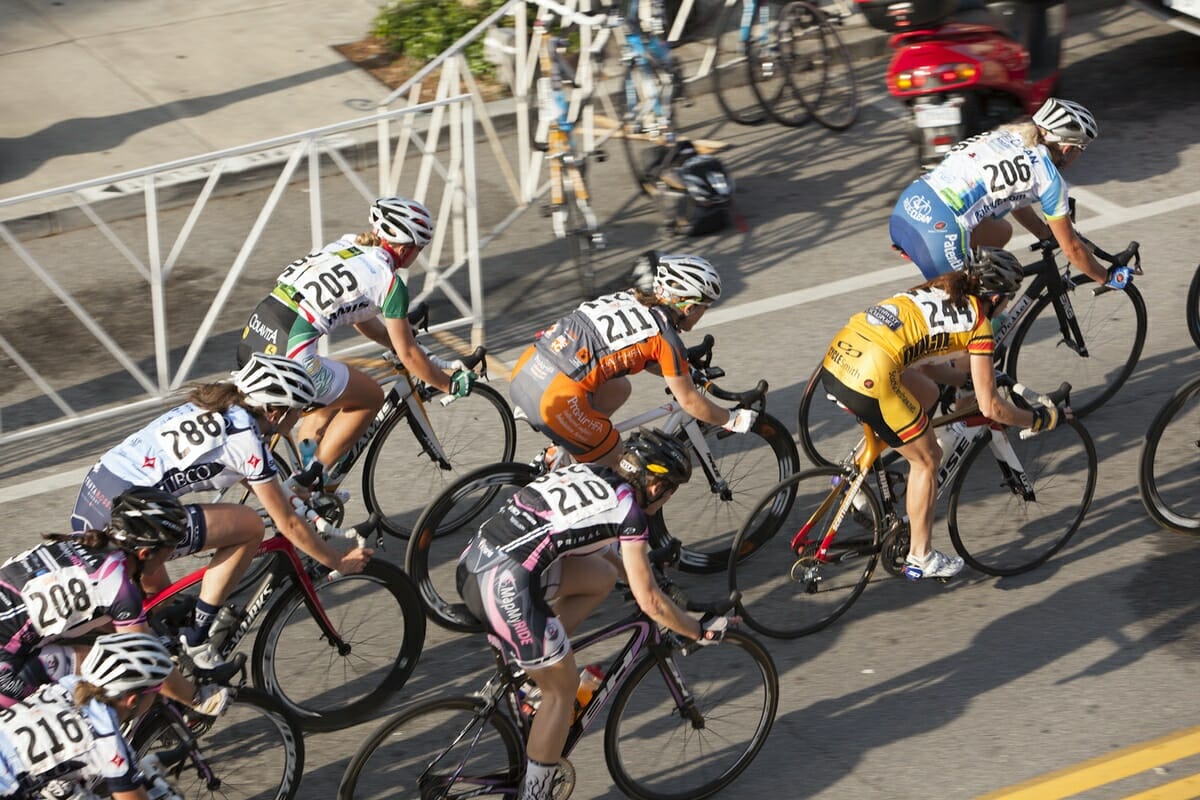By Marie McAden
Break out the cowbells! The Beaufort Memorial Cycling Classic returns to the Lowcountry May 1, bringing the best criterium cyclists in the world to town for another hair-raising battle through the streets of the Historic District.

The race — one of seven competitions in the USA Crits Speed Week series — will feature 118 men and 70 women vying for a slice of a $15,000 purse. Riding at average speeds of 25 to 30 mph, the cyclists will race around a .6-mile course that starts on Bay Street and loops around Scott, Raven and Newcastle streets.
It’s free to watch the race, one of the few professional sporting events offered to the public at no charge.
Criterium, or crit, racing doesn’t get the hype of long-distance cycling events like the Tour de France, but it’s much more exciting for onlookers to follow. Rather than see the cyclists speed by once, spectators can watch them pass dozens of time. In the Cycling Classic, the women will make 50 laps, the men 75.
“It’s a blast,” said event organizer Don “DG” Veitch. “Because the course is short and compact, you can walk the whole route and watch the riders blaze down the straightaways and maneuver into the tight turns.”
 Announcers will provide play-by-play commentary on all the action and analyze the strategies the cyclists use to get ahead of the pack. Competing as teams, the riders plan moves to get their strongest member in the best position for the final sprint across the finish line.
Announcers will provide play-by-play commentary on all the action and analyze the strategies the cyclists use to get ahead of the pack. Competing as teams, the riders plan moves to get their strongest member in the best position for the final sprint across the finish line.
“In racing, it’s all about aerodynamics,” Veitch explained. “You can’t stay in front for a very long time.”
During the course of the race, team members may be assigned to sit-in and conserve their strength. Drafting, or riding behind another cyclist in their slipstream, can save up to 30 percent of a rider’s energy.
To keep the race at a high speed, cyclists compete for prime (pronounced “preem”) laps, in which the fastest rider on a particular lap wins a prize. The primes serve to ensure racers do not ride slow to save themselves for the final laps. It also sorts out the different types of racers in the group: those who compete solely to win prime laps, those who will race for the overall win and the “helper” riders assigned to aid a teammate in pursuit of the win.
Whatever the rider’s mission, the criterium will test his or her ability to handle a bike in tight and often dangerous situations. With fellow riders in close proximity on all sides, cornering is vital, as is jockeying for strategic positioning in the group throughout the race. Cyclists must be at the peak of physical fitness to be able to go on the attack as well as chase when other riders attack.
A team’s strategy may include blocking or disrupting the race by soft pedaling in an organized chase. It can work to tire the field of riders more quickly. Once the group realizes they have slowed, they will have to work harder to regain the front group.
Another popular tactic is the breakaway, where one or more riders splits from the main pack. Watch for teammates in the chase to see if they are just blocking or working to catch up.
The most strategic part of the race occurs in the closing laps, often after a breakaway. The seemingly unorganized pack of 100 riders will swarm into an organized group of teams with each team looking to get their best sprinter to the finish line first by clearing the way and providing a draft for the rider.
The team that can get four or five riders to the front to keep the speed high and protect their designated sprinter will ultimately win the race.
“People line the course, ringing cowbells, cheering and whistling as the riders go by,” DeVito said. “It really helps to keep the cyclists’ energy level up.
For more information on the Beaufort Memorial Cycling Classic, visit www.lowcountrycyclist.com.
NISSAN LEAF TO LEAD THE PACK
The 190 athletes competing in the 6th annunal Beaufort Memorial Cycling Classic don’t have to worry about breathing in gas fumes from this year’s pace car. That’s because it’s 100 percent electric.
A Nissan LEAF, which will lead the way for 125 laps through downtown Beaufort, produces no emissions or engine noise like standard gas-powered cars. In fact, it doesn’t even have a tailpipe.
“It’s eco-friendly,” said Whit Gilman, general manager of Hilton Head Nissan, the dealership sponsoring the pace car. “It doesn’t use gas like hybrids, so there’s no exhaust. It’s the perfect car to use for a bicycle race.”
The pace car will stay in front of the pack throughout the race as a safety precaution to ensure the roads are clear for the cyclists. While the average speed of the competitors is 25 to 30 mph, the sprinters in the group can accelerate to 40 mph.
That’s no problem for this compact. The LEAF can do 80 mph with its 110 hp synchronous electric motor. And it has a 100-mile range on a full charge.
The LEAF came out in 2011 and sells for about $35,000. However, buyers are eligible for a $7,500 tax credit.
“The more times you drive past the gas station, the cooler the car gets,” Gilman said. “When everyone else is fretting about the price of gas, you’ll be smiling.








